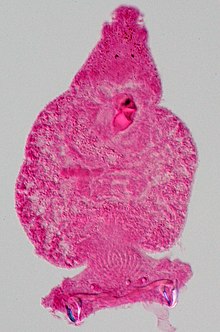Pseudorhabdosynochus
| Pseudorhabdosynochus | |
|---|---|
 |
|
| Pseudorhabdosynochus morrhua | |
| Scientific classification | |
| Kingdom: | Animalia |
| Phylum: | Platyhelminthes |
| Class: | Monogenea |
| Subclass: | Monopisthocotylea |
| Family: | Diplectanidae |
| Genus: |
Pseudorhabdosynochus Yamaguti, 1958 |
| Species | |
|
See text |
|
See text
Pseudorhabdosynochus is a genus of monopisthocotylean Monogenean, included in the family Diplectanidae.The type-species of the genus is Pseudorhabdosynochus epinepheli (Yamaguti, 1938).
The genus includes more than 80 species, which are all parasitic on the gills of marine fish, especially groupers. Since groupers are mostly abundant in warm waters, species of Pseudorhabdosynochus are found in warm parts of the oceans, especially in coral reefs, but species have also been found in deep-sea groupers. Several species of Pseudorhabdosynochus are pathogens of maricultured groupers.
All species of Pseudorhabdosynochus are small animals, ranging 0.3–1 mm in length.
As most monogeneans, they are flat, with an anterior head bearing four oculi and head glands, a main elongate body and a posterior haptor. The digestive system includes an anterior muscular pharynx, and two lateral intestinal branches (or caeca); as in all Platyhelminthes, there is no anus. The haptor, in the posterior part of the body, is a specialized organ used to attach to the host. The haptor includes sclerotized elements, namely a ventral bar, two lateral (dorsal) bars, two ventral hooks and two dorsal hooks, and fourteen hooklets. As in most diplectanids, the haptor bears special, characteristic, structures called squamodiscs. The squamodiscs (one ventral and one dorsal) of species of Pseudorhabdosynochus are made up of numerous rodlets aligned as concentric rows.
Adults are hermaphroditic. The reproductive organ include a single ovary and a single testis. As in all diplectanids, the ovary (or germarium) is anterior to the testis and loops around the right intestinal caecum. Species of Pseudorhabdosynochus are characterized by a sclerotized male copulatory organ, or "quadriloculate organ", which has the shape of a bean with four internal chambers. The vagina includes a sclerotized part, which is a complex structure with several chambers and canals, generally used for the diagnosis and differentiation of species.
...
Wikipedia
